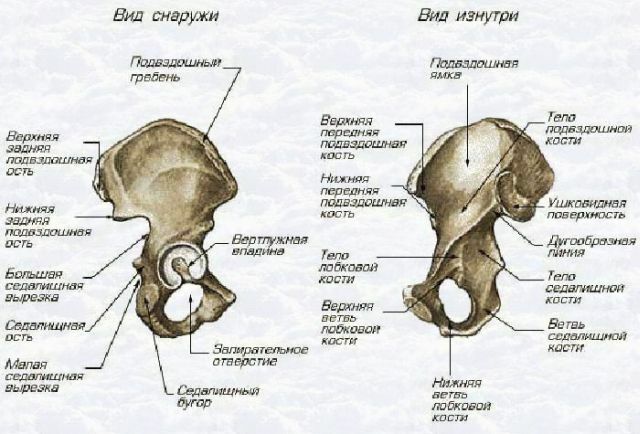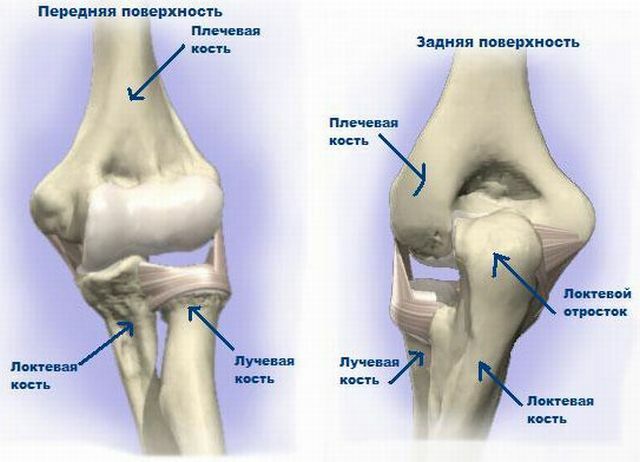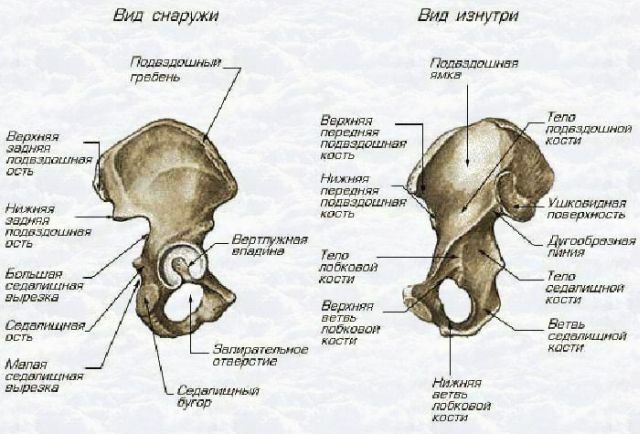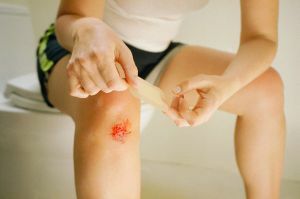 The knee joint belongs to the group of the largest joints of the human body.
The knee joint belongs to the group of the largest joints of the human body.
It plays the role of a kind of hinge that allows you to unbend and bend the shin. However, unlike the latter, the knee joint is also characterized by such an ability as rotation( movement in a circle).
Its anatomy is represented by the following components: tibia, femur and patella.
Contents of the article
- What happens when a bruise?
- Causes of trauma - commonplace
- Varieties of injury
- What happens when an injury occurs?
- Diagnosis of injury
- Severe knee injury: how to help the patient?
- Methods of therapy
- What else can be done with a knee injury?
- Grandmother's recipes to help
- Possible complications
- Preventive measures
What happens when a bruise?
Under the bruise of doctors mean damage to the soft tissues of a specific area of the body.
In the case of the knee, these may include:
- Skin and subcutaneous tissue .Very often with a bruise, skin is affected, resulting in a wound surface.
- Muscle fibers .As a result of damage, muscle tissues undergo strong tension, responding with spasm,
 causing pain.
causing pain. - Bundles of .If joint joints are damaged, the mobility of the knee joint is in question.
- Cartilage is a shock absorber that softens the movements. If the cartilage is threatened, the bones of the knee joint also suffer.
- Vessels .When the large vessel is ruptured, the functioning of the joint is disturbed.
Thus, the result of a bruise is the occurrence of difficulties in moving the foot and moving it in space.
In the absence of proper treatment, it is also possible to develop inflammation, both cartilage and bone tissue can be involved in this process. The result of a disastrous phenomenon is arthritis.
Causes of trauma - commonplace
Most often, a knee injury is obtained when falling, for example, when ice, at the time of exercise.
To provoke damage to the knee joint, it can also fall onto this part of the leg of a heavy object or its squeezing( in the case of an accident).
One way or another, the cause of the injury is a mechanical effect.
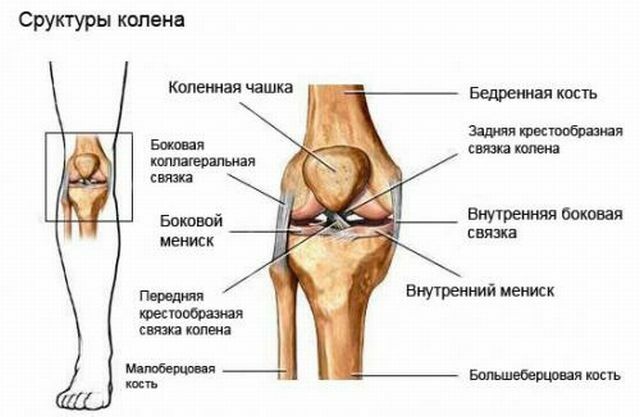
Varieties of trauma
The following pathologies are distinguished:
- without fractures;
- with bone or joint fractures;
- without dislocation;
- with a dislocation.
In addition, with a bruise, all components of the knee joint or parts of it may suffer:
- full bruise;
- partial( muscle, tendons, surrounding tissues, ligaments).
What happens when an injury occurs?
The main symptoms of a knee injury include:
- Hemarthrosis is a collection of blood in the joint cavity. This sign can be expressed in varying degrees, and it is from it that the manifestation of the remaining symptoms largely depends.
- The pain of , which can take more intense character during movement or objective examination.
- Swelling of the damaged area .It is the result of swelling of soft tissues.
- Blueing of the skin over the injured area is a consequence of a vascular integrity disorder.
- Mobility disorder , which is caused by a mechanical obstruction in the joint.
The severity of a symptom depends on a number of factors: the area of the damaged area, the location of the injury, the impact force on the tissue, the angle of the impact.
Diagnosis of injury
Diagnosis of the injury, primarily based on objective examination data, which implies a visual inspection of
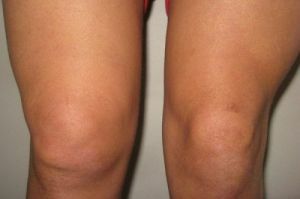
. Tumor is a common occurrence when the knee joint
of the injured joint is bruised, as well as the palpation of the injury site.
The next stage of diagnostics is a medical-diagnostic puncture. With its help determine the presence of fluid( blood) in the joint cavity, if necessary, remove it, which leads to a decrease in intra-articular pressure and a reduction in pain.
With an injury of the knee joint, an X-ray examination is also shown, in the course of which the integrity / damage of the bone tissues is verified. If a fracture occurs, the location of the fragments is determined.
ultrasound will help specialists assess the current state of the structural components of the joint.
In some cases, endoscopy is necessary - the procedure for puncturing the site of the injury and insertion into the joint cavity of the endoscope. So you can assess the severity of the injury.
Severe knee injury: how to help the patient?
In the case of a knee injury, first aid is urgently needed. The fate of the joint largely depends on the literacy of the subsequent actions.
We consistently perform the following:
- We limit the load to the damaged area.
- We apply a piece of ice or any cold object to the sore spot. This will help prevent swelling and relieve pain.
- In case of severe, persistent pain, analgesics are needed( Analgin, Ibuprofen).
- Apply a tight bandage( in the absence of bandage, you can use any other material).Our goal is to fix the knee well, but at the same time leave the limb muscles in a comfortable state.
- The patient is laid in such a way that the injured knee is higher.
Treatment methods
Treatment of a knee joint injury is provided to a patient in order to:
- relieve pain and swelling;
- interrupts the development of the inflammatory process;
- restoration of the functionality of the joint.
Medical treatment of the resulting injury implies the taking:
- Non-steroidal anti-inflammatory drugs .Among the most frequently used tools are: Oxygen;Analgin;Diclofenac;Indomethacin. These drugs are taken or injected into the joint.
- Khondroprojectors ( Collagen Ultra, Fermatron) - drugs, which include elements of joint fluid. With their help, its deficiency is compensated for and the normal functioning of the joint is maintained. Medicaments are injected into the joint cavity with a thin needle.
What else can be done with a knee injury?
An integral part of restorative therapy is exercise therapy. You can start training only with the permission of the doctor. Exercise in the case of knee injury must be preceded by a warm compress, which increases the flow of blood to the affected area.
Begin with stretching exercises, performing them at a calm pace:
- in a sitting position we reach the knees, socks;
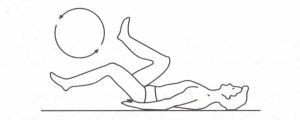
- lying on the belly and placing a small cushion under the thigh of the diseased limb, we make a springy movement in the direction downwards;
- sitting on the edge of the chair, we put a sick leg over the healthy one and pull it back, gradually putting more and more effort;
- we lay down on the floor and we tie the load to the ankle of the diseased limb, bend the healthy leg in the knee, lift the load above the floor to a height of about 10 cm, fix the position for a few seconds, relax.
All exercises must be performed up to 10 times. After stretching, you can proceed to:
- walking( the upper part of the trunk slightly bends forward), we walk 10 minutes;
- half-squats - 20 times;
- power exercises on the upper part of the body( pushing dumbbells in the prone position);
- cycling - 10 minutes.
Will not hurt with a bruise and massage. Assign it usually 10-12 days after the injury.
Grandmother's recipes to help
There are many medicinal products of traditional medicine that can alleviate the suffering of a patient with trauma.
To treat a knee injury at home, such recipes are used:
- Fresh cabbage leaf is fixed on the knee, leave for an hour, then change. Repeat several times in a row.
- Dry, shredded wormwood, mixed with a small amount of petroleum jelly, leave in a hot oven for 2 hours. With the finished composition, we lubricate the damaged area 3 times a day.
- The pulp of aloe is mixed with fresh honey, we put on the bruise and bandages. We leave for several hours.
- We rub the sore spot with laundry soap.
Possible complications of
In the absence of proper measures with a strong knee injury, a number of complications may develop:
- Fluid accumulation in the joint cavity. Causes severe swelling and joint enlargement in size. A plaster cast is shown, sometimes a puncture.

- Fracture or dislocation.
- Rupture / extension of ligaments.
- Damage to the meniscus - cartilaginous joint plate. Such a trauma can lead to disability.
- Bursitis( irritation / inflammation of the bursa).When infection develops purulent bursitis, the treatment of which implies surgical intervention.
Prevention measures
To prevent knee joint injuries, it is recommended to follow certain advices for preventive purposes:
- Maintain a good physical shape of your legs. Do exercises for stretching the back of the shin and hamstring, make the ascent of the straight legs, pulling the knees to the chest.
- Do not load your knees( avoid deep squats and slopes).
- Give preference to shoes that have good support for the arch of the foot, avoid heels.
- Regularly change shoes for sports.
Injury of the knee joint is very serious in nature, can cause partial or complete loss of joint functionality. Therefore, qualified medical care is an inalienable condition for a favorable outcome and further full-fledged life.

